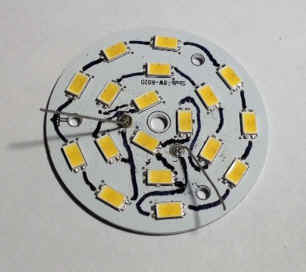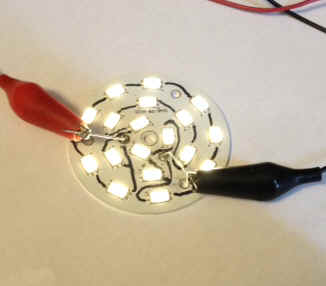
There are 18 LED's wired in two series strings of 9 LED's. In this picture I drew an outline of the circuitboard tracks showing the series/parallel connections. I soldered two wires at each end of the string.
LED bulbs are starting to replace the CFL as the CFL has been replacing the incandescent light bulb. Prices have dropped to less than US$4.00 in some big box retailers. Color temperatures close to the soft filament colors people are used to. They are very durable and can replace "rough duty" light bulbs. They are not temperature (cold) sensitive like CFL's. However they don't like very high temperatures or enclosed globes. Here in the US they're readily available in Lowe's, Home Depot and starting to appear in some WalMarts.
I have personally replaced every bulb in my house with LED lighting. Previously I replaced every incandescent bulb with CFL's. If I were to turn every LED light on in my house they would draw less power than two 60 watt incandescent bulbs.
I've only had two LED bulbs fail and they were ones that I recently purchased so I chalked that up to infant mortality. Rather than trying to find the purchase receipt and getting them replaced, I decided to find out what was inside. After fidgeting around with the base and trying to pry the plastic diffuser off I finally got one apart. What I found was a simple 24 volt switching supply and an array of LED's on a heatsink.

There are 18 LED's wired in two series strings of 9 LED's. In this picture I
drew an outline of the circuitboard tracks showing the series/parallel
connections. I soldered two wires at each end of the string.

Applying a current regulated 24 volts illuminated the array.
What I found that generally fails is the switching supply, primarily the integrated circuit switcher chip. In this case it was split in half from overheating. Generally the power supply is the weakest link and most likely to be what goes bad in LED lights. The LED's themselves don't usually go bad but after a number of years they will grow dim.
I have since repurposed these arrays into 12 or 24 volt lighting systems.